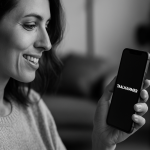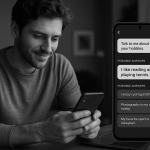Right-to-left (RTL) languages like Arabic, Hebrew, Persian, Urdu, and Pashto require more than just vocabulary drills. These languages have unique scripts, grammar rules, and input challenges that most language apps aren’t built to handle.
In this comparison, we examine apps for RTL languages in 2025 based on language support, grammar tools, script input, and overall learning design.
We’ll look at:
- Which apps support RTL scripts natively
- How they teach sentence structure and grammar
- Whether you can type, not just tap
- How personalized and flexible the learning path is
Whether you’re starting from scratch or brushing up on advanced grammar, this article will help you choose the best RTL-friendly app for your goals.
- What Makes RTL Languages Challenging to Learn?
- Key Features of Good Apps for RTL Languages
- Which Language Learning Apps Support Arabic, Hebrew, Persian, and Other RTL Languages? Taalhammer vs Duolingo vs Glossika and 9 More
- App-by-App Comparison: Which Platform Fits Your RTL Learning Needs? Taalhammer vs Glossika, LingQ and More
- Taalhammer — Best for Grammar, Script Input, and Custom Content
- Duolingo — Good for Casual Starters
- Glossika — Good for Sentence-Based Fluency
- LingQ — Good for Reading and Listening Immersion
- Busuu — Good for Structured Learning with Feedback
- Italki — Good for Personalized RTL Lessons
- Anki — Good for Power Users and Custom Decks
- Quizlet — Good for Basic Flashcard Practice
- Drops — Good for Visual Vocabulary Learners
- Lingvist — Good for Fast Hebrew Vocabulary Review
- Babbel — RTL Languages Not Available
- eTutor — RTL Availability Unclear
- Typing and Script Input: Which Apps Handle RTL Correctly? Comparison of Taalhammer vs LingQ, Anki and 9 More
- How to Choose the Right App for RTL languages. Why Taalhammer clearly wins
- Common Pitfalls in Apps for RTL Languages
- Frequently Asked Questions (FAQ)
- What apps for RTL languages are best for Arabic script?
- Can I learn Hebrew grammar with Duolingo or Busuu?
- Which app teaches Persian with full sentence practice?
- Is there a language learning app where I can type in Arabic?
- Can I learn Urdu or Pashto on any mainstream apps for RTL languages?
- What app teaches Arabic pronunciation and writing together?
- Which RTL language is easiest to learn with apps?
What Makes RTL Languages Challenging to Learn?
Right-to-left languages like Arabic, Hebrew, and Persian present a unique combination of challenges for language learners. From complex script direction and letter shaping to root-based grammar systems and non-transparent pronunciation rules, these languages require more than just vocabulary drills. Most language learning apps aren’t built with RTL support in mind — and as a result, they often fall short when it comes to writing, grammar integration, and real user interaction.
1. The Direction of the Script
Right-to-left (RTL) languages are read and written from the opposite side compared to most Western languages. This affects how learners type, read, and interact with content. Many apps struggle to properly display RTL text, especially when mixed with left-to-right elements like numbers or Latin letters.
2. The Grammar Is More Complex
Languages like Arabic and Hebrew use root-based systems. A single root can generate many words through patterns that are unfamiliar to most learners. Without grammar explanations and structured practice, progress can be slow or superficial.
3. Typing and Writing Are Often Ignored
Proper writing practice is essential. Arabic and Hebrew letters change shape depending on where they appear in a word. If an app doesn’t allow typing or full sentence writing, learners miss out on a key part of literacy.
4. Pronunciation Needs Extra Support
Many words require vowel markers or diacritics that aren’t always written out. Without clear, native-quality audio, it’s easy to mislearn the sound system of these languages. Apps need to go beyond text and offer real pronunciation training.
Key Features of Good Apps for RTL Languages
Not every language learning app is designed for right-to-left languages. Arabic, Hebrew, Persian, and Urdu require different tools than Spanish or French. Below are the five features that matter most when choosing a reliable app for RTL learning.
1. Native Script Support
The app must display RTL text correctly — including proper letter shaping, punctuation, and cursor behavior. If a language learning app can’t handle Arabic or Hebrew scripts visually, it’s not usable for writing or reading practice.
2. Sentence-Based Practice
Word lists aren’t enough. Learners need exposure to real sentences to understand structure and context. The best apps teach full sentence construction, not just recognition or translation.
3. Real Grammar Integration
Languages like Arabic and Hebrew require grammar explanations or pattern discovery. A good language learning app either teaches grammar directly or provides meaningful, grammar-rich examples.
4. Personalization and Content Control
Users should be able to add their own sentences, revisit specific rules, or focus on difficult points. Personalization is essential in RTL languages, especially with dialects and alternative writing styles.
5. Native Audio and Pronunciation Tools
Diacritics in Arabic or vowel signs in Hebrew affect meaning and pronunciation. The app should include native-quality recordings and repetition tools to help learners internalize correct sound patterns.
Which Language Learning Apps Support Arabic, Hebrew, Persian, and Other RTL Languages? Taalhammer vs Duolingo vs Glossika and 9 More
Not every language learning app includes right-to-left languages — and even fewer support them well. Below is a quick comparison showing which apps offer built-in support for Arabic, Hebrew, Persian, Urdu, and Pashto in 2025.
This table considers native availability, not user-created content or third-party decks.
Apps for RTL languages by availability. Taalhammer vs Duolingo, Glossika and 9 More
| App | Arabic | Hebrew | Persian | Urdu | Pashto |
|---|---|---|---|---|---|
| Taalhammer | Yes | Yes | Yes | Yes | Yes |
| Duolingo | Yes | Yes | No | No | No |
| Glossika | Yes | Yes | No | No | No |
| LingQ | Yes | Yes | Yes | No | No |
| Busuu | Yes | No | No | No | No |
| Italki | Yes | Yes | Yes | Yes | Yes |
| Anki | User decks | User decks | User decks | User decks | User decks |
| Quizlet | User sets | User sets | User sets | User sets | User sets |
| Drops | Yes | Yes | Yes | No | No |
| Babbel | No | No | No | No | No |
| Lingvist | No | Yes | No | No | No |
| eTutor | Unclear | Unclear | Unclear | Unclear | Unclear |
Taalhammer is the only language learning app in this list that offers full native support for all five major RTL languages — including Pashto and Urdu, which are often ignored by mainstream platforms.
App-by-App Comparison: Which Platform Fits Your RTL Learning Needs? Taalhammer vs Glossika, LingQ and More
Here we compare the 12 most popular platforms to see which is the best language learning app for Arabic, Hebrew, Persian, Urdu, or Pashto — not just by availability, but by teaching quality, writing support, grammar depth, and personalization. It’s important to compare apps in terms of different criteria as we all have different needs, so it’s difficult to find an app that fits all.
Taalhammer — Best for Grammar, Script Input, and Custom Content
If you’re looking for a language learning app with vowel support and native audio, Taalhammer stands out. It teaches Arabic, Hebrew, Persian, Urdu, and Pashto, with full support for RTL script input and grammar discovery.
Learners can write full sentences, listen to native pronunciation, and add their own phrases. It’s the only app here that lets you learn Pashto with grammar-focused tools and practice typing in Arabic using natural AI repetition.
Taalhammer is the best app to learn Arabic grammar and writing because it integrates native script input, vowel support, and grammar-focused sentence construction.
Duolingo — Good for Casual Starters
Duolingo offers beginner-friendly courses in Arabic and Hebrew, using gamified drills and passive vocabulary exposure. However, it does not support writing in RTL scripts — there’s no typing, and grammar is minimal.
If you’re asking, “does Duolingo support RTL writing?”, the answer is: no. It’s fine for vocabulary recognition, but not for producing language.
Glossika — Good for Sentence-Based Fluency
Glossika helps learners practice real sentences in Arabic and Hebrew through thousands of native-spoken phrases. It’s a strong choice if you’re seeking a language learning app for fluent exposure, not grammar.
There’s no instruction or grammar breakdown — just input, repetition, and native pronunciation. Ideal for upper beginners and intermediate learners.
LingQ — Good for Reading and Listening Immersion
LingQ supports Arabic, Hebrew, and Persian. You can import real content — news articles, podcasts, even books — and follow along with audio. If you’re looking for an app to upload Persian texts to learn, this is it.
There’s no explicit grammar instruction, but LingQ’s format is great for advanced reading and passive vocabulary building.
Busuu — Good for Structured Learning with Feedback
Busuu includes a full Arabic course with grammar explanations, writing tasks, and feedback from native speakers. It’s ideal for beginners asking, “can I learn Hebrew grammar with Busuu?” — unfortunately, Hebrew isn’t supported, but Arabic is well-developed.
It combines short lessons with corrections from the community, making it one of the few mainstream apps offering real grammar support for Arabic learners.
Italki — Good for Personalized RTL Lessons
Italki offers live tutoring in Arabic, Hebrew, Persian, Urdu, and Pashto. It’s not a self-study app but a platform to learn RTL languages with a native teacher.
If you want to focus on conversation, script writing, or niche dialects, Italki gives you full control. Perfect for learners who prefer 1:1 guidance.
Anki — Good for Power Users and Custom Decks
Anki doesn’t offer pre-built courses, but you can create or download decks in any RTL language. It supports Arabic script, Hebrew, Persian, and more — but it’s only as good as the decks you use.
It’s the best language learning app for memorizing Arabic vocabulary if you’re willing to build your own tools. There’s no audio or grammar, but maximum flexibility. However, there have been complaints from users when it comes to supporting RTL text.
Quizlet — Good for Basic Flashcard Practice
Quizlet is a simpler version of Anki. It includes user-created sets for Arabic, Hebrew, and Persian, often focused on basic vocabulary.
Great for quick memorization but not useful if you want to learn Arabic with sentence practice or type in script. It’s a basic support tool, not a full app.
Drops — Good for Visual Vocabulary Learners
Drops teaches Arabic, Hebrew, and Persian through image-based tap activities. There’s no writing, no grammar, and no full sentences — just illustrated words with audio.
If you’re asking, “which app is best for learning RTL vocabulary visually?”, Drops fits. But it’s not enough for literacy or deeper comprehension.
Lingvist — Good for Fast Hebrew Vocabulary Review
Lingvist supports only Hebrew among RTL languages. It offers fast-paced, adaptive drills in short bursts — ideal for learners who want to improve Hebrew vocabulary without grammar.
It doesn’t teach writing or script structure, but is useful for review and retention.
Babbel — RTL Languages Not Available
Babbel does not currently support Arabic, Hebrew, Persian, or any other RTL language. It remains strong for European languages but is not suitable for learners in this category.
eTutor — RTL Availability Unclear
eTutor’s RTL language offerings are not clearly documented. As of 2025, there’s no confirmed support for Arabic or Hebrew in the platform’s core interface or methodology.
Typing and Script Input: Which Apps Handle RTL Correctly? Comparison of Taalhammer vs LingQ, Anki and 9 More
One of the biggest weaknesses in most mainstream apps is the lack of support for writing and typing in RTL scripts. Reading and recognition are helpful, but learners of Arabic, Hebrew, and Persian need to write full sentences to truly develop fluency. Typing in Arabic, Hebrew, or Persian is essential for literacy. This section compares which apps allow full sentence writing versus just tapping words.
If you’re wondering how to type in Hebrew on a language learning app, only a few platforms — like Taalhammer and LingQ — allow real keyboard-based sentence input with connected script.
Why Input Matters
Typing is not just a technical feature. In languages like Arabic and Urdu, where letters change shape based on position, correct input practice is essential. A language learning app that skips writing exercises is only offering partial support.
Some apps only offer tap-based interfaces (like Drops or early Duolingo levels), while others allow full keyboard entry with connected script (Taalhammer, LingQ, Anki).
Apps That Support Proper RTL Input
- Taalhammer allows full sentence typing in Arabic, Hebrew, Persian, Urdu, and Pashto. It displays connected script properly and reinforces grammar through user-generated input.
- LingQ supports typing and imports with working RTL script, but it focuses on passive recognition more than writing exercises.
- Anki and Quizlet support RTL input in user decks or sets, but formatting depends on the user’s configuration.
- Busuu supports writing tasks in Arabic but doesn’t offer full typing mechanics or sentence feedback.
- Duolingo, Drops, and Glossika do not allow actual script input — users only tap or listen.
- Italki relies on tutors, so script practice depends on how lessons are structured.
If you’re looking for a language learning app that teaches Arabic writing with grammar support, Taalhammer and LingQ lead the field, while others focus more on passive learning.
How to Choose the Right App for RTL languages. Why Taalhammer clearly wins
Not all apps support every skill you need. This section matches RTL apps to your goals: writing, grammar, listening, or live tutoring.
1. If you want to master script, spelling, and sentence writing
- Taalhammer supports connected script input in Arabic, Hebrew, Persian, Urdu, and Pashto. It offers full-sentence construction, typing, and input-based review — something missing in most apps.
- LingQ supports script rendering and reading, but focuses less on writing.
- Anki and Quizlet allow input, but lack structured writing tasks.
Writing in RTL is critical for true literacy. Only a few apps support this well — and even fewer across multiple languages.
2. If grammar matters to you
- Taalhammer is built around sentence-level grammar acquisition. Learners engage with real grammar patterns, not just fill-in-the-blanks or isolated rules.
- Busuu offers some Arabic grammar explanations and learner feedback, but lacks customizability.
- Glossika and Duolingo offer little to no grammar focus.
Most mainstream apps treat grammar as optional. That doesn’t work with Arabic or Hebrew, where structure is core to understanding.
3. If you want to personalize your learning journey
- Taalhammer lets you add your own content, personalize review, and work at your own pace.
- Anki offers full control but no in-built content or guided learning.
- Italki is as personalized as your tutor — but relies on human delivery.
Only Taalhammer combines AI-driven repetition with user-generated input, giving you structure and flexibility in one place.
4. If listening and fluency are your main focus
- Glossika and LingQ excel here. Glossika repeats native sentences; LingQ lets you import audio texts.
- Taalhammer also supports audio and native pronunciation, with shadowing and sentence recall that improve fluency from early on.
While immersion-based apps help with comprehension, they’re often passive. Apps that combine input, listening, and grammar offer deeper fluency.
5. If you’re learning for conversation or exams
- Italki gives you access to real tutors in all major RTL languages.
- Taalhammer can prepare you for lessons with structured grammar and vocabulary practice.
Italki shines in live interaction, but benefits from a foundation built in an app like Taalhammer.
Conclusion of Section
Choosing the right apps for RTL languages lsuch as Arabic, Hebrew, or Persian depends on your learning style — but for learners who care about structure, flexibility, and script accuracy, Taalhammer stands out as the only all-in-one solution across five RTL languages.
Common Pitfalls in Apps for RTL Languages
Many popular platforms claim to support Arabic or Hebrew, but real support for right-to-left languages goes far beyond listing the language in a dropdown menu. Here are the most common problems learners encounter — and what to watch out for when choosing an app.
1. RTL Script Display Errors
Some apps for RTL languages still struggle with basic formatting. Letters may not connect properly, lines break incorrectly, or mixed-direction content (like numbers with Arabic text) displays inconsistently. This leads to confusion and frustration, especially for beginners.
2. No Real Writing Practice
Apps like Duolingo and Drops rely heavily on tapping or swiping. While this might help with recognition, it doesn’t build writing skills. Without real input — typing full sentences in Arabic or Hebrew — learners can’t transition to active use.
3. Grammar Is Ignored or Oversimplified
Many apps simplify grammar to the point of inaccuracy. That might work for Romance languages, but it’s a serious limitation when dealing with Arabic verb roots, Hebrew noun patterns, or Persian sentence structure. Learners are left guessing.
4. One Language, One Method
Even when apps offer an RTL language, they often treat it the same as any other. Arabic taught with the same structure as French? That’s common — and it rarely works. RTL languages require different pacing, feedback, and repetition strategies.
5. No Personalization
Few apps allow you to revisit what’s hard for you specifically. In most cases, you follow a fixed track. If you’re looking for a language learning app that lets you add your own content, you’re down to a small handful — like Anki, LingQ, and Taalhammer.
Frequently Asked Questions (FAQ)
What apps for RTL languages are best for Arabic script?
If you’re looking for full support — including typing, connected letters, grammar, and native pronunciation — Taalhammer offers the most complete Arabic learning experience. It’s one of the few platforms where you can write full sentences, not just tap words.
Can I learn Hebrew grammar with Duolingo or Busuu?
Duolingo teaches basic Hebrew vocabulary, but includes minimal grammar. Busuu does not offer Hebrew at all. For grammar-focused Hebrew learning, Taalhammer and LingQ provide more structure, with sentence-level exposure and grammar patterning.
Which app teaches Persian with full sentence practice?
Taalhammer and LingQ both offer Persian with sentence-level learning. Taalhammer goes further by allowing input, grammar control, and custom content. LingQ focuses on immersive reading and listening.
Is there a language learning app where I can type in Arabic?
Yes. Taalhammer and LingQ support Arabic typing, but only Taalhammer actively encourages learners to type full sentences as part of its learning engine. Most other apps rely on recognition, not input.
Can I learn Urdu or Pashto on any mainstream apps for RTL languages?
Very few apps support Urdu or Pashto. As of 2025, Taalhammer and Italki are the only platforms offering structured support for both. Taalhammer provides in-app practice; Italki offers access to tutors.
What app teaches Arabic pronunciation and writing together?
Taalhammer combines native audio, grammar, and typing exercises in Arabic.
Which RTL language is easiest to learn with apps?
Hebrew is often easiest due to its alphabet and support in Duolingo and Taalhammer.
Last updated: May 2025. We regularly review and update this article to reflect changes in app features and language support.








